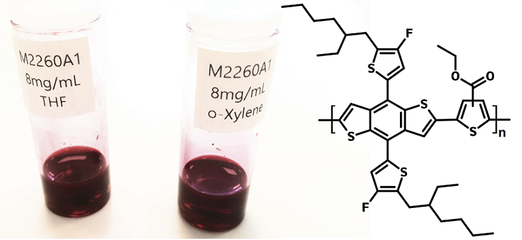PTO2, high quality polymer donor
Simple structure with great device performance efficiencies
Specifications | MSDS | Literature and Reviews | Technical Support
PTO2 is an alternating wide band-gap copolymer with electron-donating benzodithiophene (BDT) and electron-withdrawing thiophene carboxylate ester as the main backbone units. PTO2 enjoys good solubility in non-halogenated solvents, i.e. xylenes and THF.
With an efficient charge generation at a low driving force, an efficiency of 14.7% was achieved in a single-junction OPV by using polymer donor PTO2 and a non fullerene acceptor IT-4F.
PTO2 is considered as good replacement for PBDB-T-2F (PM6) or PTB7-Th for it similar but simpler structure, while maintaining great device performance efficiencies at lower costs.
Wide bandgap copolymer
For high efficient OPV applications
Luminosyn™
High purity, batch-specific GPC data, available larger batch orders and higher molecular weight
Worldwide shipping
Quick and reliable shipping
Green energy materials
Processable in non-halogenated solvents
PClTO2, a chlorine version of PTO2, is also available to our customers. Please refer to our collection of green energy materials for non-halogenated solvents processing choice of non-fullerene acceptors (NFAs).
Luminosyn™ PTO2
Luminosyn™ PTO2 is now available.
High purity
PBTO2 is purified by Soxhlet extraction with methanol, hexane and chlorobenzene under an argon atmosphere
Batch-specific GPC data
Batch specific GPC data is always available for your thesis or publication
Large-quantity orders
Plan your experiments with confidence with polymers from the same batch
General Information
| Full name | Poly[(2,6-(4,8-bis(5-(2-ethylhexyl)-4-fluoro)thiophen-2-yl)-benzo[1,2-b:4,5-b']dithiophene)-alt-(2,2-ethyl-3(or4)-carboxylate-thiophene)] |
| Synonyms | PE12, PFTO2 |
| Chemical formula | (C41H44F2O2S5)n |
| CAS number | n.a. |
| HOMO / LUMO | HOMO = -5.56 eV, LUMO = -3.67 eV [2] |
| Soluble in | THF, o-xylene, chloroform, chlorobenzene and dichlorobenzene |
| Recommended Processing Solvents at 10mg/ml | THF (8mg/ml), o-xylene (8mg/ml), chloroform |
|---|---|
| Classification / Family | Organic semiconducting materials, Wide band-gap polymers, Organic Photovoltaics, Polymer solar cells, NF-PSCs, All-polymer solar cells (all-pscs), Green energy materials. |
Batch Details
| Batch | Mw | Mn | PDI | Stock Info |
| M2260A1 | 63,527 | 29,379 | 2.16 | Low stock |
| M2260A2 | 120,565 | 55,455 | 2.17 | In stock |
Chemical Structure

Device Structure
Device structure: ITO/PEDOT:PSS (10 nm)/PTO2:ITIC-4F (1:1, 100 ± 5nm)/PFN-Br (5 nm)/Al (80 nm)
| Thickness (nm) | VOC (V) | JSC (mA cm-2) | FF (%) | PCE (%) |
| 100 | 0.91 | 21.5 | 75.0 | 14.7 |
MSDS Documentation
Literature and Reviews
- Achieving Over 15% Efficiency in Organic Photovoltaic Cells via Copolymer Design, Y. Cui et al., Adv. Mater., 31 (14), 1808356 (2019); DOI: 10.1002/adma.201808356.
- Wide bandgap polymer donors for high efficiency non-fullerene acceptor based organic solar cells, K. He et al., Mater. Adv., 2, 115 (2021); DOI: 10.1039/d0ma00790k.
- 14.7% Efficiency Organic Photovoltaic Cells Enabled by Active Materials with a Large Electrostatic Potential Difference, H. Yao et al., J. Am. Chem. Soc., 141, 19, 7743–7750 (2019); DOI: 10.1021/jacs.8b12937.
